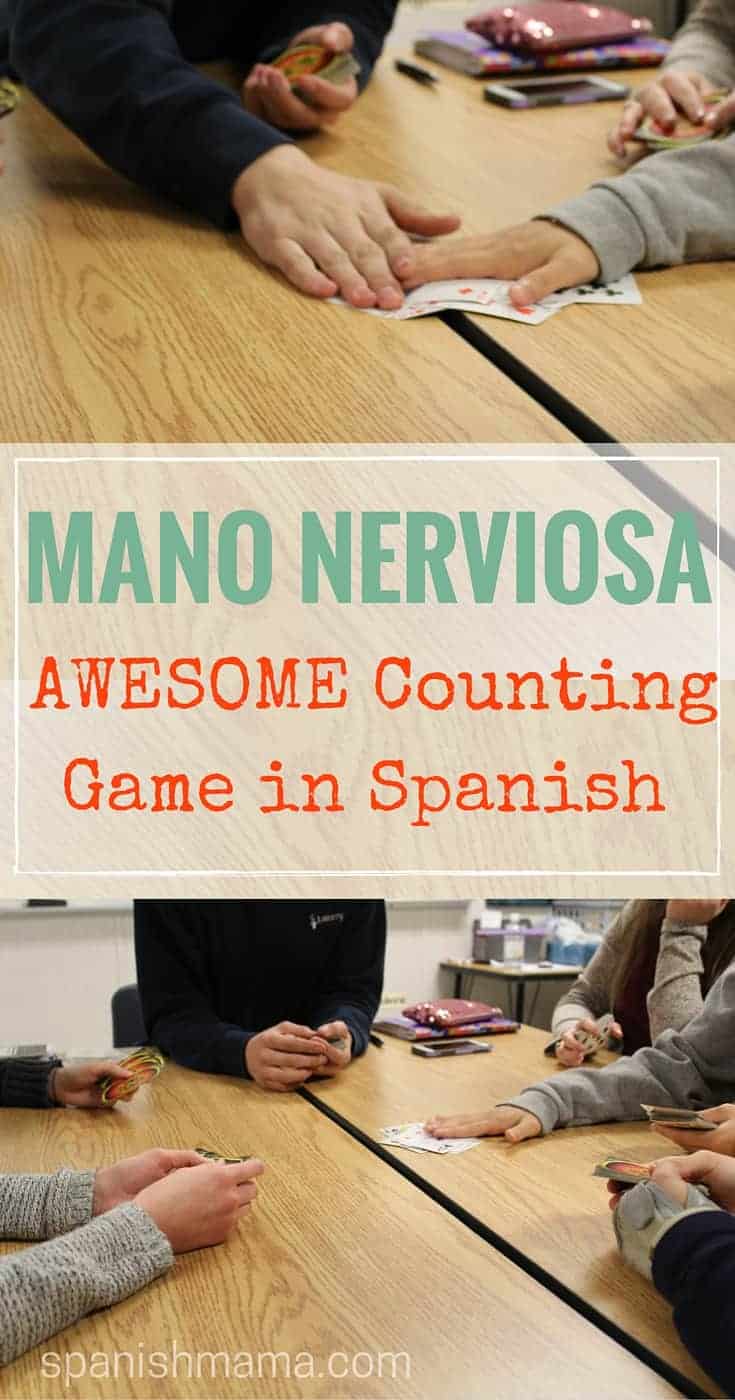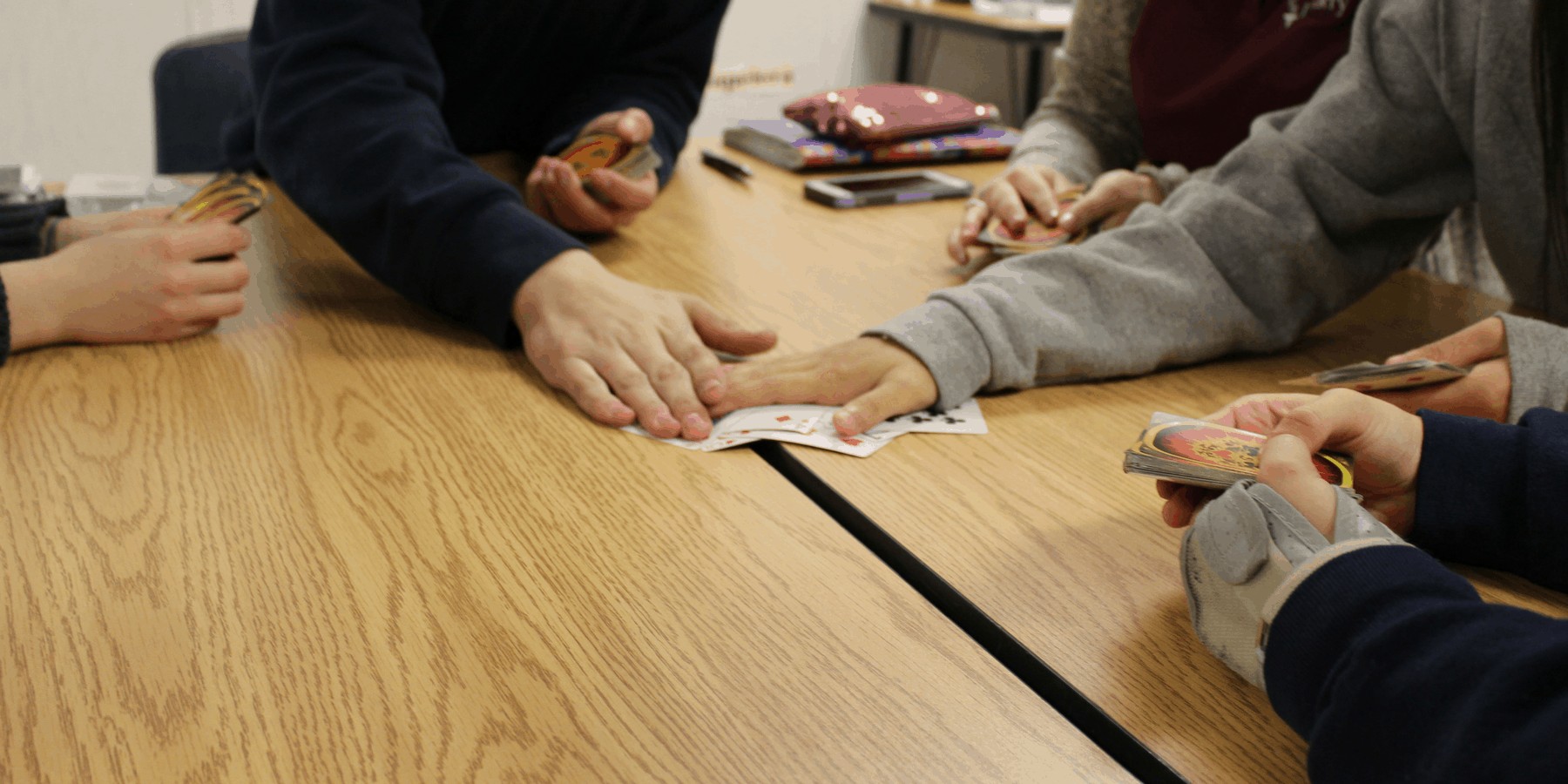Mano Nerviosa: Awesome Game to Learn the Numbers in Spanish
Inside: Learn the numbers in Spanish with the game Mano Nerviosa.
I moved to the Peruvian jungle at 22, without really knowing Spanish. I learned on the fly: getting a mototaxi, or hanging out with friends after a day of teaching. We’d sit around the kitchen table playing cards, late at night– all the young people in the house.
I knew the least Spanish out of anyone. This was unfortunate, especially when someone said something clever or cracked a joke. The rest would be crying from laughter, while I waited for the translation (usually to be told it didn’t translate!).
It was also very motivating, as I learned Spanish. One of the games we played was Mano nerviosa, a numbers-based game. My future husband was super-competitive like me, and would always win. You better believe I studied those numbers on the side, just to beat this annoying creído.
(We ending up dating and getting married anyway, of course. I still get just as mad when he beats me at cards!)
And this is all part of why I love games in the classroom. When I teach, I’m always reaching for that kitchen table.
I’m thinking of how to create that feeling of some great inside joke happening; that there’s magic on the other side. I want them to feel that by learning Spanish, they’ll access that other side and feel the world open up too.
For me, the perfect lesson happens when the task is so engaging everyone forgets we’re there to “learn” Spanish. Some games have every single person engaged, practicing exactly what you want them to practice. Mano Nerviosa is one of those game, and my students beg for it! Once everyone has the hang of it, use it as a brain break, class reward, or for Spanish club.
When I started teaching, I realized it was perfect for learning numbers 1-13– and actually knowing them. Most students come to me being able to count, or learn 1-10 fairly quickly. If you ask them what seven is, though, they can only get there by counting.
This game fixes all that, and works for any topic students learn by chanting or recitation (months, days, ABC’s– you would just need the cards for it).
HOW TO PLAY MANO NERVIOSA
(My Peruvian friends in the video said “una” instead of “uno”– a regionalismo you might need to explain to your class.)
Divide the students into groups of 4-6. (Can be played with 2-3 if needed.)
Ace = 1
2 – 10 = 2 – 10
Jack = 11
Queen = 12
King = 13
(Optional- use the Jokers and write 14 on them)
Divide all of the cards evenly among the players, and use two decks if possible. One person starts by laying a card face up, in the middle, and saying uno (or one— any language works!). The play continues clockwise, laying down cards and counting. When everyone counts to 13 (or 14), they start back at 1 and count up again. Anytime a number is placed in the middle that matches the number spoken, the players can slap the pile. The first person to hit the card gets the entire pile to keep. The first person to get all the cards in the game wins.
ALSO– and this is cool– if anyone loses all their cards, they can still slap in. Everyone is involved and engaged with a chance to win, right until the end!
Here’s a another (older!) video showing the game being played:
A few more caveats/notes:
- Give a strict lecture about losing turns, being out of the game, etc. by being too rough. They REALLY get into this one!
- If you have super-shy, sensitive kids, make sure they are in a less competitive group. It can be helpful to group loosely by ability, so the competition is even.
- If you have students slapping every time– or to up the competition– tell them they have to deduct ten of their own cards and place them in the middle pile for each false slap.
- Do a class tournament. Put the students in groups of 4-6, and then have the winners, 2nd place, 3rd place, etc, move to the same tables and compete against each other. This is fun because everyone has the chance to beat their group (on their own level), to the end.
If you’re looking for games to play in Spanish class, make sure to check out my Spanish Classroom Games page!
Here are my top game pages you can quickly jump to:
Fun & Interactive Vocabulary Games for the Language Classroom
Icebreakers for Middle and High School
End-of-the-Year or Review Games for the Language Classroom
Like it? Pin it!








This is great. One question: should I use 2 decks per group of 4-6 kids? Thanks!
I think it’s best to use more than one deck for 6+ people. Otherwise the game is too short.
My kids LOVED this game!!! Thank you so much for sharing, it’s made all the better that it’s a game actually played in Peru! Love love love!
So glad!
Una tarjeta…
Oh didn’t think about that! The native speakers who edited the video mentioned it was slang, not proper, to say “una” but we all could be wrong for sure. 🙂
Great game. I just want to ask you. How can I play this game with more numbers let’s say I’m teaching numbers 1-30 or to 50 can we still play this game or is there another version for more numbers?
You can adjust it (“change” the numbers, as in 1 = 21, 2 = 22, 3 = 23, etc.) but it can be a little tricky. I usually use it with beginners to just do lower numbers!
You could make your own deck with any numbers you want…. just copy on cardstock and consider laminating?
This was the best! I just played this game with my 4th graders with numbers 50-100 and it was perfect! They started at 50 and kept going up, saying the whole number but matching just the ones place. They would say cincuenta y cinco and slap if it was a 5. After a couple of rounds, if the student made a mistake and said the wrong number and their group caught them, they would owe a card to all the other people in their group. Once they got to 100, they started back at cincuenta.
What happens when someone in the group runs out of cards? They’re out?
I used to play this game growing up in Peru, too (we just called it “Nervioso”), but with slightly different rules that might answer your question: The goal for us was to get rid of cards, so that the person who was last to slap the table would be the one to take all the cards in the pile.
So, this set up a few variations for how the game/round ends:
1. The first one to get rid of all their cards WINS (and you can just start a new round).
2. People progressively get out of the game by discarding all their cards until just one person is left with all the cards (i.e., the loser). [This is the version you’d most likely use if you wanted to add a punishment for the loser.]
3. Same as (2), but people who discard all their cards have to keep slapping the table in order to stay out. If they’re the last ones to slap at any point, they’re basically forced back into the game. [It makes rounds last much longer, but with the right people, it’s the most fun version!]
Hope this makes sense!